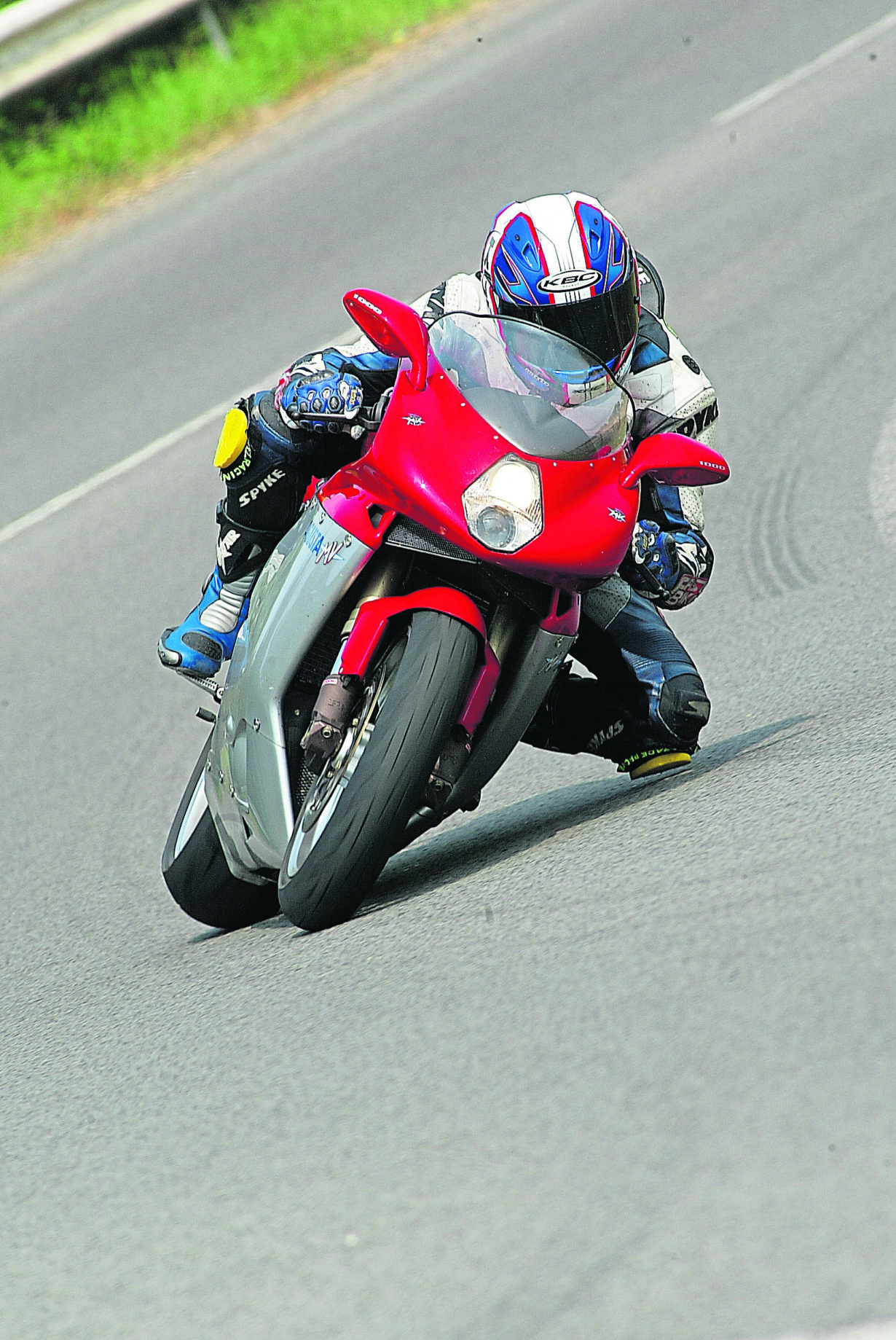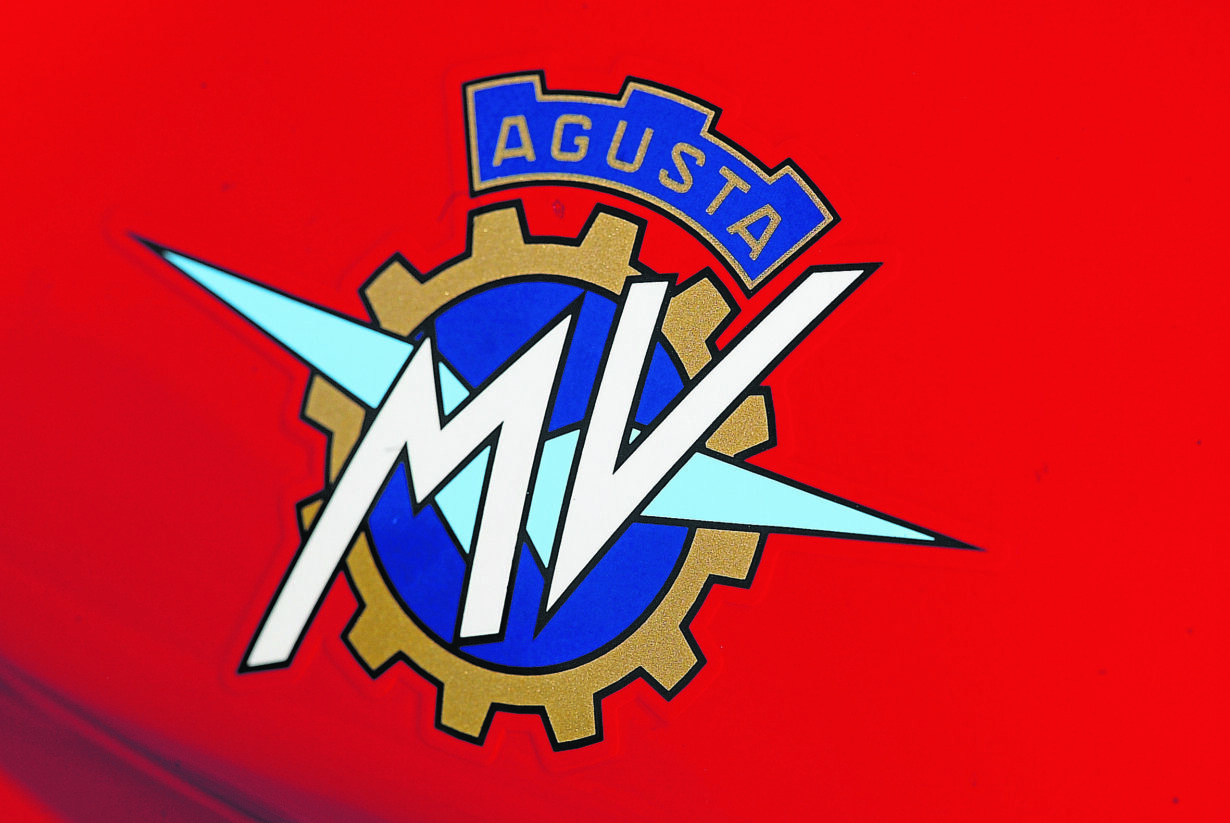Jon Urry gets stuck in…
The problem with a fanfare is that when the trumpeters have run out of puff, you are left with a bunch of red-faced people holding a long brass tube in their hands in silence and not a lot else. Which is exactly what MV Agusta found when the excitement that heralded the 1999 launch of their F4 750 had abated, and riders discovered that it was actually a bit of a slug. A great looking one, but a slug none the less. So, what did MV do? Simple. In 2004 they gave it some balls! Big ones, like the cojones you find on a wild bull…
The F4 1000 arrived five years after the F4 750 in late 2004, which was bang on time to catch the wave of excitement that the latest generation of litre bikes from Japan had created. Having had a chance to see what the Japanese were claiming in terms of power and weight, MV made certain that this time their new sportsbike was more than a match.

Firm foundations
Boasting a hugely impressive claimed 164bhp with 109Nm of torque, the F4 1000 was most certainly on a par with the Japanese, who were all claiming (hugely optimistic) power figures in the 170bhp area. And not only that, but according to MV it tipped the scales at 192kg, which although 20kg heavier than Yamaha claimed for the YZF-R1, was a touch more accurate when it came to reality. How had a relatively small company like MV managed to match the cutting-edge Japanese factories? The secret lay in the F4 750’s foundations, which were actually far stronger than most had imagined.
As slow as the F4 750 was, the fact of the matter was that its engine had been part designed by Ferrari and technology such as its radial valve arrangement was actually pretty clever. It wasn’t MV’s fault they backed the wrong horse when it came to capacity, that was just down to bad timing. So, by increasing the bore and stroke the new F5, which was the new motor’s development name, was born. But in typical Italian style, it wasn’t all plain sailing from the start.
Despite having developed their own fuel injection system for the F4 750, MV managed to completely balls it up on the early F4 1000 models. To be fair it was never that good on the 750, but with fewer ponies to deal with its failings weren’t too apparent. However, the F4 1000 was another issue – it’s all very well and good making a 164bhp motor, but without an element of finesse in the throttle action it can all go very wayward very quickly. Which is what happened to the early F4 1000s.

New bike, new flaws
Those who were left disappointed by the 750 saw the 1000’s spec sheet and, believing that MV had got it right this time, handed over £14,000 for the new F4. They certainly got what they wanted in terms of power, but it lacked nearly all resemblance of control.
It wasn’t long until stories of on/off switch throttles and the bike’s inability to hold a constant speed again put a dent in MV’s sales. Yes, the F4 looked glorious and when on the pipe was an absolute rocket, but its fuelling was so poor it was almost unrideable at anything other than flat-out. In town or traffic, it was a pain, and if you wanted an easy life yet still had huge amounts of power on tap, the new breed of great-looking Japanese inline fours were the best bet. The F4 fell out of favour, and it wasn’t until the vastly improved ‘square-pipe’ generation that their reputation really recovered. So why should you consider owning an early F4 1000 nowadays?
The F4 1000 is a perfect case of MV creating the bare bones of a great bike and then relying on other people to iron out the creases. The F4 is jaw-droppingly gorgeous to look at and comes with an excellent chassis and top-spec components, it’s just that during development MV didn’t quite get their balance correct. So now it’s down to you.

You can pick up a beauty of an early F4 for in the region of £6000, which if you think about it is the same price as a new Yamaha MT-07! What would you rather have, a parallel twin commuter or an Italian superbike? Spend in the region of £1500 getting the harshness taken out of the suspension and the jerk removed from the fuel-injection system via a bit of dyno time by someone who knows their stuff, and you will be left with something very special indeed. And for less than half the price of a new litre bike, which is the key to thinking about owning an MV F4 1000.
There is no denying this is a flawed motorcycle, but it is one that is reasonably easy to sort out and once done is an incredible machine to ride. As well as looking fantastic, that inline four snarls like a cornered wild cat when up its rev range and the MV’s chassis is top drawer. If you are prepared to ignore the doubters and put some effort in yourself, this is a wonderful used buy that will repay your faith (and money) invested in it through sheer, unadulterated, enjoyment.
Price guide: £6000-£9000
Cheapest private: £6400
6950 miles, black, stunning 2007 bike, some small scratches
Our choice private: £8999
2009 bike with 2462 miles and a FSH with some extras
Cheapest dealer: £6990
10,760 miles, excellent 2006 bike in silver with a few extras
Our choice dealer: £8000
Just 265 miles, immaculate 2006 bike in silver and blue.
Ex-demo: n/a
+ Engine, looks, exclusivity
– Fuelling, reliability, service costs

Other things to know…
Model updates
The original F4 1000 was replaced in 2010 by the ‘square exhaust’ generation. Identified by its square instead of round exhaust tail pipes, the whole bike was revised to smooth out the old machine’s rough edges as well as boost performance and reduce weight. Eight-stage traction control was added, weight trimmed by 10kg, and the power increased through a completely reworked motor. It is a far more refined bike to ride, as well as considerably more reliable, but lacks some of the original machine’s wild character. In 2013 the ‘short-stroke’ engine was introduced with the R, RR and RC, the only F4 models remaining in MV’s range.
Fuel injection
Early MV models suffer terribly from poor fuel-injection systems, leading to horrific throttle response. You can either get a Power Commander fitted and the fuelling remapped or go for a whole new ECU from Microtec, which is the option most riders opt for as it is delivers a massive transformation as well as extra electronic features. MV experts X-Bikes (www.xbikes.cc) are fantastic at sorting out the F4’s fuelling. Give them a bell if you want your MV to run sweetly.
Fire!
The F4 1000 (and 750) have heat shielding in the right-hand fairing lowers and belly pan to protect the fairing from the exhaust pipe’s heat. When the glue starts to age this can become dislodged, leading to a melted fairing and potentially a fire. Always inspect this area for any signs of plastic damage or the paint becoming overheated.
Swingarm
As with all single-sided swingarm bikes, the pinch bolts on the swingarm can be over-tightened, causing damage to the hub. It’s a rare fault as most MVs are professionally serviced, but take a look and also ensure the eccentric adjusters move freely by altering the chain’s tension. There are also a few cases of the bearing collapsing, so give it a good wiggle and feel for movement.
Remember the 750
The F4 750 was launched in 1999 and ran until 2005. There are three generations of 750 with the final EVO 3 models the most reliable and powerful. They are often cheaper than the 1000 due to their lack of popularity, yet the SPR and SR models are surprisingly fast as well as fantastic handling. The original F4 750 is also starting to be viewed as a potential future classic, so get in there now before the prices really turn!

Service history
A good service history by a reputable MV specialist is essential on an F4 as like all older Italian machinery, there are little tricks that can be the difference between an unreliable and frustrating hound and a sweet Italian plaything. It’s not a cheap bike to look after, but if you pay a professional it is worth the investment to ensure hassle-free ownership. Well, relatively hassle-free….
Exhaust
The F4’s exhaust is stuffed full of annoying emission’s-pleasing blockages, but these can quite easily be removed. A few specialists offer a service of removing the junk and then rewelding up the OE exhaust system, which is a considerably cheaper option than forking out for an aftermarket system.
Specials
MV love to make limited-edition models and the early F4s were no exception. In 2004 an ‘Ago’ model was launched, complete with a number 1 on the fairing and lightweight wheels with upgraded brakes. The ‘Tamburini’ was also limited in its production and featured variable length intake funnels, while 2006 saw a ‘Senna’ model as well as the ‘CC’ (Claudio Castiglioni) to celebrate the boss of MV. All cost a considerable premium over the stock F4, which came in stock, 1 + 1 (with a pillion seat) and S versions.
Gremlins…
It’s Italian, so you have to expect a few gremlins… The F4 1000’s sidestand switch can fail; the fasteners don’t stand up very well to a lack of care and corrosion is common; badly adjusted suspension quickly ruins its handling; and reg/recs like to stop working. But that’s just character, isn’t it?…
Specs:
Engine:
Type: 998cc, liquid-cooled, 16v, inline four
Bore x Stroke: 76mm x 55mm
Compression: 13:1
Fuelling: Electronic fuel injection
Tested Power: 153bhp @ 10,750rpm
Tested Torque: 103Nm @ 9800rpm
Chassis
Frame: Steel trellis and aluminum cast sections
F Suspension: 50mm inverted Marzocchi forks, fully adjustable
R suspension: Sachs monoshock, fully adjustable
Front brakes: Six-piston Nissin calipers, 310mm discs
Rear brake: Two-piston Nissin caliper, 210mm disc
Dimensions:
Wheelbase: 1408mm
Seat Height: 810mm
Dry Weight: 192kg
Fuel Capacity: 21 litres
Speed:
0-60: 3.51 sec
0-100: 9.91 sec
0-140: 12.39
Stg ¼ mile: 11.22sec @ 134.68mph
Standing mile: n/a
Top speed: 173.05mph
Boxout> Running costs:
Service interval:
Minor: 3800
Major: 7500
Valve clearances: 7500
Service costs:
Minor: £300
Major: £500
Valve clearances: £500
Right fairing: £600
RH Engine casing: £65
Brake lever: £85


